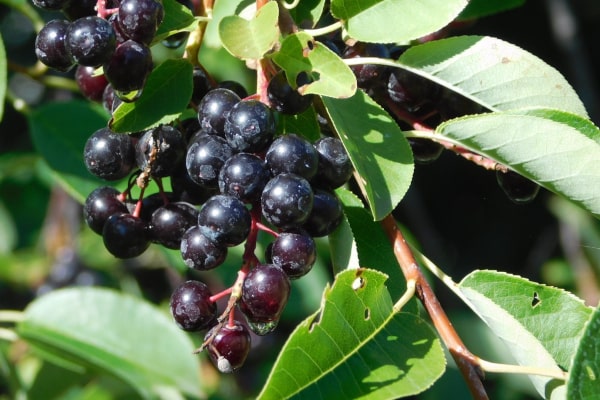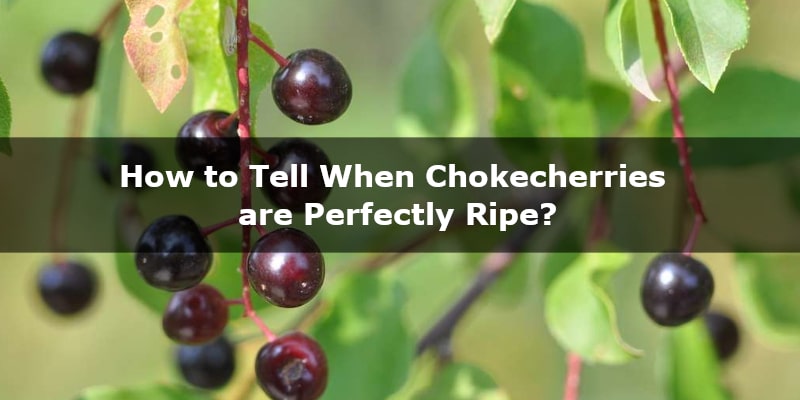It’s not that easy to tell when chokecherries are ripe.
However, there are a couple of signs that indicate that chokecherries are ripe, so read on to find out!
How to Tell When Chokecherries are Ripe?
In order to tell when chokecherries are ripe, it’s best to examine the color and taste of the fruit. If the fruit is dark purple, or dark red and tastes mildly sweet with a cherry taste, it’s time to harvest chokecherries.
Chokecherry is a large shrub, typically reaching 20 feet (6 meters) high with an irregular rounded-oval crown. Chokecherry produces a profusion of cylindrical white flowers in the spring. The flowers give way to a bounty of dark red berries in the summer, which attract plenty of birds.
The berries grow wild on small tree-like shrubs, often along woods edges or roadsides. They need full sun to thrive, so you won’t find them deep in the woods.
The fruits are edible in small quantities, but chokecherries aren’t usually eaten raw, but converted by juicing the fruit, then turning that juice into jelly, syrup, fruit leather, and wine.
In this article, you will find out all the signs that chokecherries are ripe, and more useful information about harvesting chokecherries.
Signs that chokecherries are ripe:
Color
Color is the best indicator that chokecherries are ripe. Ripe chokecherries have dark purple color. Usually, chokecherries are red in the mid-summer, and it takes about a month, or more, for them to turn black and mature. Some varieties ripen at a deep red, so you should check other factors of ripeness.
In the photo below, you can see ripe chokecherries. At the bottom, there are slightly underripe chokecherries that are also good to harvest.

Taste
Mature chokecherries can be dark purple, but if they don’t taste good, it’s a sign they aren’t ripened yet. If chokecherry is very tart and acidic, it means that it isn’t mature yet. Mature fruit is mildly sweet, with only the tiniest hints of astringency, and a cherry taste.
Size
If you’re not sure if chokecherries are ripe, you can always measure the size of the fruits. Mature fruits are about (1⁄4–1⁄2) 6–14 mm in diameter. Fruit smaller than that shouldn’t be picked yet.
Softness
Underripe chokecherry fruits are hard when you press them. Ripe fruits should be moderately soft, but not too soft. If you squash the fruit, using a little strength, it’s super soft, mushy, or leaky, it means the fruit is already overripe.
Time of the Year
A good indicator of chokecherry ripeness is the time of the year. In the North, these fruits are ripe from mid-August to mid-September. In the South, you can pick them up from late June until August.
Birds Presence
If you see birds pecking chokecherry fruits, it means that they taste good enough to be picked.
What Happens if You Pick Chokecherries Too Early, or Too Late?
It’s best to pick chokecherries at the right time when they’re perfectly ripe. If you pick them too early, it might be bad, because their taste is astringent. That means that they can’t be used for anything.
But the good news is that if you pick chokecherries when they’re slightly underripe, and they will be ripe within a few days, they can ripen even if they’re harvested.
Picking chokecherries too late means that you pick a fruit that’s mushy, leaky, and tastes bad. Again, if the fruit is seriously overripe, you can’t use it. However, if chokecherry is only slightly overripe, and it still tastes good, you can use it for jelly, syrup, fruit leather, or wine.
One chokecherry is good on the tree for about 1 week, so as soon as you see the first signs of maturity, you should start harvesting. During harvesting season, you’ll be able to pick fresh chokecherries at least every two days.
How Weather Can Impact When to Pick Chokecherries?
It’s normal to harvest chokecherries from August to September, or from June to August under normal weather conditions. However, extreme weather conditions can slow down the process of ripeness, and fruits will be ripe a few weeks later than normal.
Early springs and late frosts might affect chokecherry life. This fruit tree emerges from dormancy and bloom in the early spring. But if there is an unseasonal, late frost at that time, the frost can kill the delicate blossoms and dash any hopes of an abundant harvest for that year.
The changing climate is also bringing severe droughts and flooding. These changes make fruit trees susceptible to poor growing seasons, pests, fungal diseases, and more.
Extreme heat can also be a major issue. Growers in hot climates are now dealing with scorching temperatures that can literally cook growing fruit right on the tree.
How to Pick and Store Chokecherries?
Picking chokecherries is extremely easy. First, if you’re not sure, you should identify the chokecherry tree.
To identify a chokecherry tree, take a look at the fruit. The fruit is small and round and hangs in easy-to-pick clusters. They start out a light green color, and then progress through yellow, to bright red, and then finally a deep red, or purple when ripe.
An identification mark of chokecherry is a seed. The seed takes up somewhere between 1/3 and 1/2 of the volume of the fruit.
The leaves of chokecherry plants vary in size from about 2 to 4 inches (5-10 cm). Like most stone fruits, they’re long and oval-shaped and come to a point at the end. The edges have small serrations, and the leaves themselves come out alternately from the stem.
Once you’ve identified a chokecherry tree, you can just easily pick clusters off the plant into a bucket or other vessel. Pick only ripe fruits or the ones that are slightly underripe.
Once you’ve selected your chokecherries, it’s important to rush them into a fridge as soon as you can. Cherries are a pretty sensitive fruit, and they lose their juicy taste in room temperature environments. They also absorb water when rinsed, so hold off on washing ’em until right before you’re about to eat or bake.
Store unwashed chokecherries between layers of paper towels, but if that’s too much work, focus on keeping them dry and cold at a minimum.
Stored correctly, chokecherries will last for around a week in the fridge. If you want to keep them longer, consider freezing the fruits in airtight plastic bags. By the time you’re ready to use them for jelly, syrup, fruit leather, or wine, they’ll still be juicy and delicious!
Sources
backyardforager.com, prairienursery.com, orchardpeople.com, practicalselfreliance.com, tasteofhome.com

